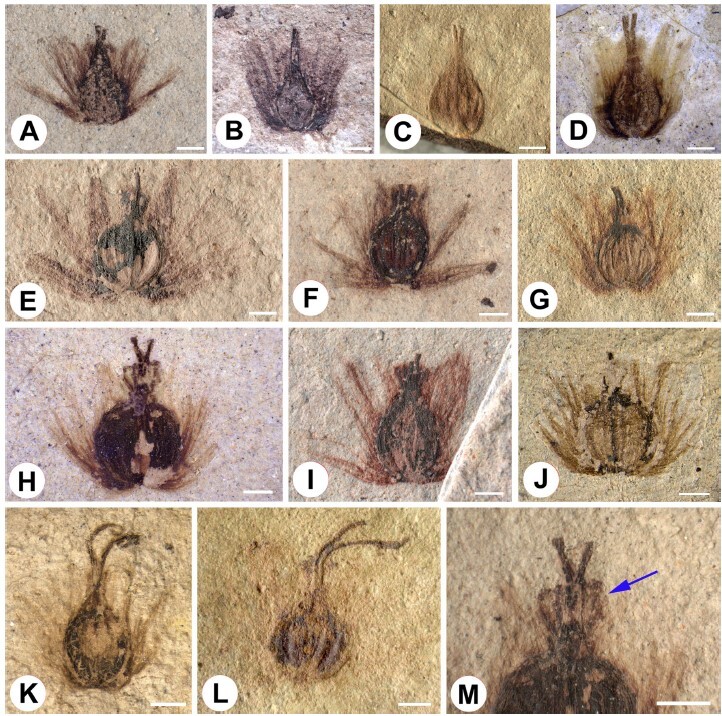ORIGINAL ARTICLE
Tufted wind-dispersed fagalean fruits, Pogonokarydion gen. nov., from the Upper Eocene Florissant Formation of Colorado, USA
1
Florida Museum of Natural History, Dickinson Hall, Gainesville, Florida 32611-7800, USA
2
University of Minnesota Herbarium, Bell Museum, 2088 Larpenteur Ave. West University of Minnesota,
St. Paul, MN 55113, USA
Publication date: 2024-12-31
Acta Palaeobotanica 2024; 64(2): 360-366
HIGHLIGHTS
- New analysis refutes the prior identification of these disseminules as Juncus
- Wind-dispersal hairs arising from the base of the nut derive from bracts
- The late Eocene Florissant flora includes both extinct and extant fagalean genera
KEYWORDS
ABSTRACT
Wind-dispersed comose fruits from the Late Eocene of Florissant, Colorado, USA, are recognized as
a new genus of fagalean affinity. Pogonokarydion crassulum (Cockerell) gen. et comb. nov. disseminules consist
of an ellipsoidal to circular nut bearing longitudinal ribs, a persistent epigynous perianth, paired styles, and
a prominent tuft of straight hairs arising from the base, which we infer to be homologous with an involucre.
Prior assignments to Juncus (Juncaceae) and Fagopsis (Fagaceae) are rejected and we argue for a position within
the Fagales, likely within, or close to, the Betulaceae. Pogonokarydion co-occurred in the Florissant flora with
other fagalean genera, including some still living today, like Quercus and Carya, and others now extinct like
Fagopsis and Asterocarpinus.
FUNDING
Florida Museum of Natural History.
REFERENCES (24)
1.
Bouchal, J., Zetter, R., Grímsson, F., Denk, T., 2014. Evolutionary trends and ecological differentiation in early Ce-nozoic Fagaceae of western North America. American Journal of Botany 101, 1332–1349. https://doi.org/10.3732/ajb.14....
2.
Bouchal, J.M., Zetter, R., Denk, T., 2016. Pollen and spores of the uppermost Eocene Florissant Formation, Colora-do: a combined light and scanning electron microscopy study. Grana 55(3), 179–245. https://doi.org/10.1080/001731....
3.
Brown, R.W., 1937. Additions to some fossil floras of the western United States. United States Geological Survey Professional Paper 186-J, 163–206. https://doi.org/10.3133/pp186J.
4.
Brown, R.W., 1954 (reprinted 2000). Composition of Scientific Words. Smithsonian Press, Washington, D.C. 852 pp.
5.
Cockerell, T.D.A., 1908. The fossil flora of Florissant, Colorado. Bulletin of the American Museum of Natural History 24, 71–109.
6.
Correa-Narvaez, J.E., Manchester, S.R., 2022. Distribution and morphological diversity of Palaeocarpinus (Betulaceae) from the Paleogene of the Northern Hemisphere. Botanical Review 88, 161–203. https://doi.org/10.1007/s12229....
7.
Evanovff, E., Mcintosh, W.C., Murphey, P.C., 2001. Stratigraphic summary and 40Ar/39Ar geochronology of the Florissant formation, Colorado. Proceedings of the Denver Museum of Nature and Science Series 4, 1–16.
9.
Knowlton, F.H., 1916. A review of the fossil plants in the United States National Museum from the Florissant lake beds at Florissant, Colorado, with descriptions of new species and list of type specimens. Proceedings of the US National Museum 51, 241–297. https://doi.org/10.5479/si.009....
10.
Leopold, E.B., Meyer, H.W., 2012. Saved in time: The fight to establish Florissant Fossil Beds National Monument, Colorado. University of New Mexico Press, Albuquerque, 139 pp.
11.
Lesquereux, L., 1883. Enumeration and description of the species of fossil plants known from the Green River Group. In: Lesquereux, L. (ed.), Contributions to the fossil flora of the Western Territories, part III: the Cretaceous and Tertiary floras. U.S. Geological Survey of the Territories 8, 135–217.
12.
MacGinitie, H.D., 1953. Fossil plants of the Florissant beds, Colorado. Carnegie Institute of Washington Publication 599, 1–198.
13.
Manchester, S.R., 1987. The fossil history of the Juglandaceae. Missouri Botanical Garden Monograph 21, 1–137. https://doi.org/10.5962/bhl.ti....
14.
Manchester, S.R., 1992. Flowers, fruits and pollen of Florissantia, an extinct malvalean genus from the Eocene and Oligocene of western North America. American Journal of Botany 79, 996–1008. https://doi.org/10.1002/j.1537....
15.
Manchester, S.R., 1989. Attached reproductive and vegetative remains of the extinct American-European genus Cedrelospermum (Ulmaceae) from the Early Tertiary of Utah and Colorado. American Journal of Botany 76, 256–276. https://doi.org/10.1002/j.1537....
16.
Manchester, S.R., 2001. Update on the megafossil flora of Florissant, Colorado. Denver Museum of Nature & Science Series 4, 137–161.
17.
Manchester, S.R., Crane, P.R., 1983. Attached leaves, inflorescences, and fruits of Fagopsis, an extinct genus of fagaceous affinity from the Oligocene Florissant flora of Colorado, U.S.A. American Journal of Botany 70, 1147–1164. https://doi.org/10.1002/j.1537....
18.
Manchester, S.R., Crane, P.R., 1987. A new genus of Betulaceae from the Oligocene of western North America. Botanical Gazette 148, 263–273. https://doi.org/10.1086/337654.
19.
Manchester, S.R., Donoghue, M., 1995. Winged fruits of Linnaeeae (Caprifoliaceae) in the Tertiary of western North America: Diplodipelta gen. nov. International Journal of Plant Sciences 156, 709–722. https://doi.org/10.1086/297293.
20.
Meyer, H.W., 2003. The fossils of Florissant. Smithsonian Press, Washington, DC. 258 pp.
21.
Wang, Y., Manchester, S.R., 2000. Chaneya, A new genus of winged fruit from the Tertiary of North America and eastern Asia. International Journal of Plant Sciences 161, 167–178. https://doi.org/10.1086/314227.
22.
Wheeler, E.A., 2001. Fossil dicotyledonous woods from Florissant Fossil Beds National Monument, Colorado. In: Evanoff, E., Gregory-Wodzicki, K.M., Johnson, K.R., (eds), Fossil flora and stratigraphy of the Florissant Formation, Colorado. Proceedings of the Denver Museum of Nature & Science 4(1), 187–204.
23.
Wheeler, E.A., Meyer, H.W., 2012. A new (Hovenia) and an old (Chadronoxylon) fossil wood from the late Eocene Florissant Formation, Colorado, U.S.A. International Association of Wood Anatomists Journal 33(3), 309–318. https://doi.org/10.1163/229419....
24.
Xiang, X.G., Wang, W., Li, R.Q., Lin, L., Liu, Y., Zhou, Z.K., Li, Z.Y., Chen, Z.D., 2014. Large-scale phylogenetic anal-yses reveal fagalean diversification promoted by the interplay of diaspores and environments in the Paleogene. Perspectives in Plant Ecology, Evolution and Systematics 16(3), 101–110. https://doi.org/10.1016/j.ppee....
We process personal data collected when visiting the website. The function of obtaining information about users and their behavior is carried out by voluntarily entered information in forms and saving cookies in end devices. Data, including cookies, are used to provide services, improve the user experience and to analyze the traffic in accordance with the Privacy policy. Data are also collected and processed by Google Analytics tool (more).
You can change cookies settings in your browser. Restricted use of cookies in the browser configuration may affect some functionalities of the website.
You can change cookies settings in your browser. Restricted use of cookies in the browser configuration may affect some functionalities of the website.



